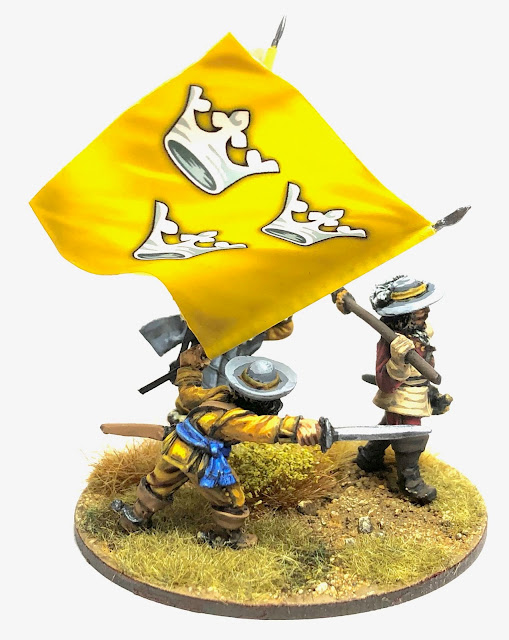" ... it was so long since they had beene last beaten,
that they had by this time forgotten how to runne away."
William Watts, The Swedish Intelligencer, Part 3.
 |
| Yellow Brigade attacking at Lützen wargame. (Photo by Alan and Elaine Daniels) |
A quote from Watts describing the destruction of the Old Blue Yellow regiments at Lutzen, 1632. This blog post covers my command base for the commander of the Yellow regiment, Nils Brahe. This is another command base for my Swedish Thirty Years War (TYW) army focused on the Lützen campaign.
The Yellow regiment is probably one of the most famous Swedish TYW regiments. Dressed in their yellow jackets they make a very striking appearance on the battlefield. This was the King's Guard and Court regiment, with the first two companies forming his Life Guard. At Lutzen they were commanded by Generalmajor Count Nils Brahe.
Count Nils Brahe was Colonel of the Swedish Yellow Regiment at Lutzen (1632). He was made Generalmajor of infantry in 1632, and at Lützen probably commanded the four leading brigades, which included the Yellow regiment which made up one brigade on its own.
 |
| Count Nils Brahe |
The Osprey Men-At-Arms on The Army of Gustavus Adolphus (1) Infantry (link) has a great picture of The Yellow Regiment in action, with Nils Brahe receiving the leg wound that would prove fatal. (He died two weeks after the battle from this wound.). Nils Brahe was a rising star in the Swedish army. He had risen through the senior ranks quickly, being Generalmajor by the age of 28, and was a favourite of the King.
I have chosen to show Nils Brahe dismounted, leading his regiment forward. He is followed by two ensigns from the Yellow Regiment. I like the way that the ensigns are braced as if advancing in to heavy fire, which at Lutzen it is likely they were. Nils Brahe on the other hand is leading by example, bolt upright, coaxing his men forward. He is finely attired, in a red suit, wearing a sleeveless buffcoat which was the fashion amongst wealthy officers on the continent. His followers are clothed in yellow suits, as befits their regiment, and one is also wearing a grey cassock like those issued to the lifeguard companies.
The figures are metal figures from Warlord Games. Nils Brahe and the cassock-ed ensign are both from the Swedish infantry box set. I think these are both cracking command figures, and it’s a pity they are only available in the boxed set. The other ensign is actually from the Warlord Scottish gun crew. His pose fitted well with the other ensign, and with a quick hat swap and hand change he was a perfect fit.
The colours are from Flags of War, of course!
I put all of my command on round bases, to differentiate from the troops on square bases. 2mm thick 6cm round from Warbases.
Until next time!
By Andy Mk1 @ FOGH.






















